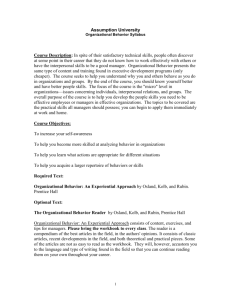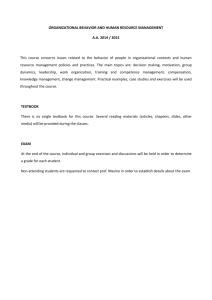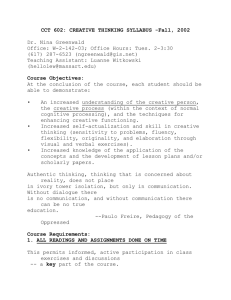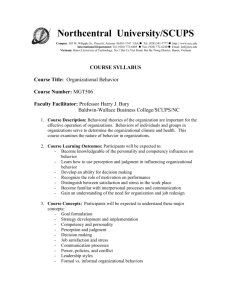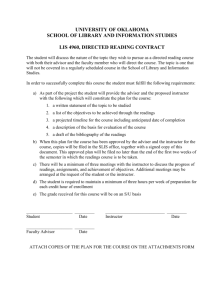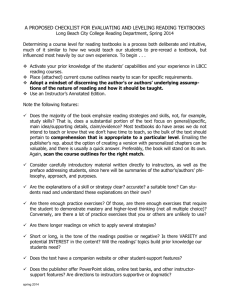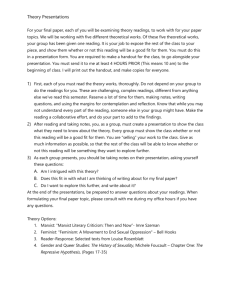Social Work 1013B INTERVENTIVE METHODS 4
advertisement
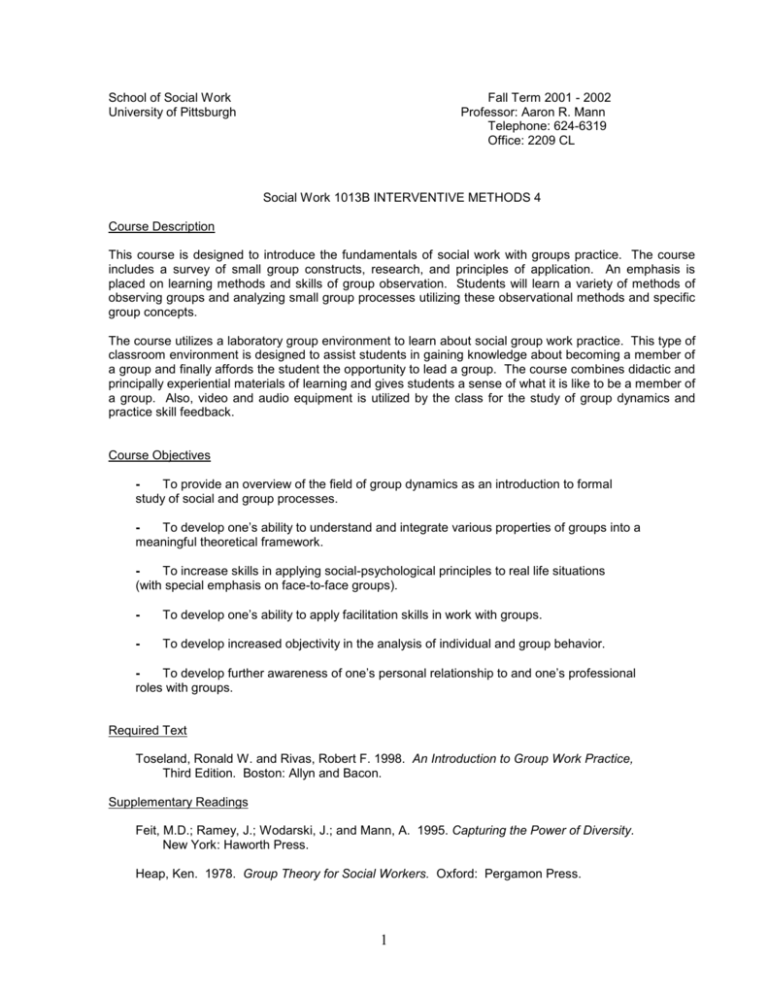
School of Social Work University of Pittsburgh Fall Term 2001 - 2002 Professor: Aaron R. Mann Telephone: 624-6319 Office: 2209 CL Social Work 1013B INTERVENTIVE METHODS 4 Course Description This course is designed to introduce the fundamentals of social work with groups practice. The course includes a survey of small group constructs, research, and principles of application. An emphasis is placed on learning methods and skills of group observation. Students will learn a variety of methods of observing groups and analyzing small group processes utilizing these observational methods and specific group concepts. The course utilizes a laboratory group environment to learn about social group work practice. This type of classroom environment is designed to assist students in gaining knowledge about becoming a member of a group and finally affords the student the opportunity to lead a group. The course combines didactic and principally experiential materials of learning and gives students a sense of what it is like to be a member of a group. Also, video and audio equipment is utilized by the class for the study of group dynamics and practice skill feedback. Course Objectives To provide an overview of the field of group dynamics as an introduction to formal study of social and group processes. To develop one’s ability to understand and integrate various properties of groups into a meaningful theoretical framework. To increase skills in applying social-psychological principles to real life situations (with special emphasis on face-to-face groups). - To develop one’s ability to apply facilitation skills in work with groups. - To develop increased objectivity in the analysis of individual and group behavior. To develop further awareness of one’s personal relationship to and one’s professional roles with groups. Required Text Toseland, Ronald W. and Rivas, Robert F. 1998. An Introduction to Group Work Practice, Third Edition. Boston: Allyn and Bacon. Supplementary Readings Feit, M.D.; Ramey, J.; Wodarski, J.; and Mann, A. 1995. Capturing the Power of Diversity. New York: Haworth Press. Heap, Ken. 1978. Group Theory for Social Workers. Oxford: Pergamon Press. 1 Heap, Ken. 1979. Process and Action in Work with Groups, The Preconditions for Treatment and Growth. Oxford: Pergamon Press. Northern, H. 1969. Social Work with Groups. New York: Columbia University Press. Zastrow, C. 1993. Social Work with Groups, Third Edition. Chicago: Nelson-Hall. Course Format Classroom instruction and assignments are geared toward enabling the students in implementing the course objectives. The instructional methods to be used will include lecture / discussion, videotapes, role play, participating exercises, and presentations and are utilized to integrate classroom and practice learning. Students are expected to participate actively in each class session and to come prepared to respond to questions concerning content of the course required assignments. As previously mentioned, this course will utilize an experiential learning approach. Grading and Evaluation The reading component of the course is focused purposefully to provide students the opportunity to plumb the depths of the content and to attain mastery of understanding. Toward that end, it is the responsibility of students to move beyond reading to actual detailed study of the content for all readings assigned. Inclass discussion will be structured to require each student to demonstrate this level of understanding. In any instances in which a student fails consistently to demonstrate the requisite levels of mastery of understanding over several class sessions, the instructor will meet with the student to alert her/him to the deficiency, to assist the student in developing a plan to correct it, and to identify academic penalties (including possible reduction in grade) for continued deficiencies in reading. In addition to detailed study of all reading assignments, each student will be expected to complete the following: 1. GROUP ANALYSIS PAPER (term paper): Ten (10) pages maximum, typed, double-spaced. This paper will focus on your observations and understanding of a small group (in which you have personal involvement) in terms of theoretical variables studied during the course. The paper should be descriptive and analytical and supported by empirical and theoretical evidence where appropriate. A guide for writing the paper is attached. The paper is due November 19th (the 12th week of the term). Refer to the Group Analysis/Term Paper Outline for more specific information. All term papers become the property of your instructor and will not be returned (therefore, it is important that you keep a copy for your records). 2. MID-TERM EXAMINATION (October 22nd) and FINAL EXAMINATION (date to be announced) 3. REACTION LOGS: Three course reaction logs or journals to be turned in September 24th (the 4th week), October 15th (the 7th week), and November 19th (the 12th week). The logs are to reflect the integration of your thoughts, readings and experiences throughout the course. You are asked to REACT (not summarize) to the course required readings, the supplementary readings, class exercises (simulations, role play), and class mandated materials. The discussion must cover: a. b. c. d. e. the significance of the material the relationship of the material to what you are learning elsewhere personal experience(s) that relate to the material what you do not agree with in the material what you do not understand about the material 4. GROUP AS A SOCIAL SYSTEM EXPERIENTIAL PROJECT: The instructor will use a random method to assign students to one of two groups. Each group is to function primarily as a Task Group in Committee format and is to: 2 A. Complete an assigned task as follows: Prepare a detailed plan for the design and adoption of revised systems of intake record and case record information which accounts fully for variations in the ethnic/cultural backgrounds and choices of lifestyle of adolescent age consumers of clinical social welfare services. The plan should include revised bases of information to be collected; revised forms for intake; theoretically based rationales for the revisions proposed; an instruction sheet (“tips”) for the professional social worker in executing the revised system; and identification of social service agencies to which the plan could be submitted. NOTE: The group may want to “role play in group” the process of asking your suggested questions of clients before deciding to definitely include these in your recommendations. B. Maintain a detailed record of the processes of group experienced in the execution of this assignment. The record must include details of each of the stages of group development experienced by the group; the various roles played by members within the group; the patterns of leadership which emerged; techniques used to evaluate the effectiveness of the group process at at least 2 points in time in the process (the group may select the 2 points); and the outcomes of the evaluations. C. Identify and integrate into the group experience portions of other typologies of groups as presented in the text for the course (refer to text pages 22 and 29-31). D. Submit on December 3, 2001 a group-prepared written analysis of the group based on the attached schema. The text of the paper should be 20-25 pages not including attachments and other appendices. The analysis MUST integrate concepts from the text, lectures, and classroom discussions and MUST include proper citation of sources. Weighting of Assignments Reaction Logs (total of 3) Mid-Term Examination Group Analysis/Term Paper Group as a Social System Experiential Project TOTAL 25% 20% 25% 30% 100% IMPORTANT NOTE: This total could be impacted by a student’s continued, uncorrected inadequate mastery of readings as discussed individually with the instructor. Additionally, more than two (2) classes missed, including excused absences, will result in a letter grade reduction. If a final examination is scheduled, the grades will be based on a total scale of 120. OFFICE OF DISABILITY SERVICES: If any student feels s/he has a disability and requires special accommodations of any nature, please let the instructor know immediately. The instructor will work with you and the Office of Disability Services to provide reasonable accommodations to ensure you have a fair opportunity to perform in class. The Office of Disability Services is located on the second floor of the William Pitt Union and can be reached at 412624-7890. Additional Information 3 Prof. Mann’s e-mail: amssw@pitt.edu Prof. Mann’s Office Hours: Posted on Office Door (2209 CL) Prof. Mann’s Staff Assistant: Ms. Mary Pat Elhattab 2108 CL 624-6348 4 COURSE OUTLINE UNIT ONE: August 27 (Week 1) THE KNOWLEDGE BASE OF GROUP WORK PRACTICE Class Group Experience Introduction to Course Handouts: Student learning contract READINGS for September 10th and September 17th: “Introduction” “Historical Developments” “1.Guidelines for Ethics” “2.Ethical Guidelines for Group Counselors” Northern Chapter II: “The Group as a Unit for Social Work Practice” Text Chapter 1 Text Chapter 2 Text Appendix A September 3 LABOR DAY HOLIDAY – No class September 10 (Week 2) History of Social Work with Groups Values and Ethics Definitions and Focus of Social Work with Groups September 17 (Week 3) Classifying Groups Typology of Treatment Groups Typology of Task Groups READINGS for September 24th: Text Chapter 3 “Understanding Group Dynamics” Review Northern Chapter II (see above) September 24 (Week 4) Understanding Group Dynamics: The Toseland & Rivas Model The Northern Model DUE: First REACTION LOG (covering August 27 to September 17) (Unit One continued) October 1 (Week 5) Leadership and Power Interactional Model of Leadership Group Leadership Skills Co-Leadership Leadership and Diversity DUE: Each student’s selection of a group for Group Analysis Paper 5 READINGS for UNIT TWO: October 8th and October 15th: “Planning the Group” “Case Examples” “Group Announcements” “Outline for a Group Proposal” “An Example of a Treatment Group Proposal” “An Example of a Task Group Proposal” Text Chapter 6 Text Chapter 15 Appendix C Appendix E Appendix F Appendix G UNIT TWO: GROUP PLANNING October 8 (Week 6) Planning the Group Planning Treatment Groups Planning Task Groups October 15 (Week 7) Basic Planning Planning Model for Group Work DUE: Second REACTION LOG (covering Sept. 24 to October 8) READINGS for October 29th Text Chapter 7 Text Chapter 8 Appendix H OCTOBER 22 (Week 8) “The Group Begins” “Assessment” “Suggested Readings on Program Activities” MID-TERM EXAMINATION UNIT THREE: STAGES OF GROUP DEVELOPMENT October 29 (Week 9) The Beginning Stage: Treatment and Task Groups Assessment READINGS for November 5th Text Chapter 9 Text Chapter 10 Text Chapter 11 Text Chapter 12 November 5 (Week 10) “Treatment Groups: Foundation Methods” “Treatment Groups: Specialized Methods” “Task Groups: Foundation Methods” “Task Groups: Specialized Methods” The Middle Stage: Treatment and Task Groups Foundation Methods: Treatment and Task Specialized Methods: Treatment and Task READINGS for November 12th Text Chapter 13 6 “Evaluation” Text Chapter 14 “Ending the Group’s Work” November 12 (Week 11) The Ending Stage: Treatment and Task Groups Evaluation and Ending the Group’s Work November 19 (Week 12) IN-CLASS PREPARATION TIME for Group Project DUE: Third REACTION LOG (covering October 18 to November 15) DUE: GROUP ANALYSIS PAPER UNIT FOUR: STAGES of GROUP DEVELOPMENT VIDEOTAPING and PROCESSING November 26 (Week 13) Discussion of Group Analysis Papers December 3 (Week 14) Discussion of Group as a Social System Projects 7 GROUP ANALYSIS PAPER (Term Paper) Write a paper covering the dimensions of group work considered in the course using the following suggestions. You may want to select a group in which you are currently a member or in which you were recently a member. This group should serve as the focus for analysis. It is important that you select a group in which you have been a member for a period of time sufficient to make it possible to analyze developments within the group beyond the formation stage, to know the individual members well enough to include factual information about all of the members or about a subgroup of them. You are to: 1) observe at length four (4) sessions of the small group; 2) to interact with the formal agency leader of the group (or an indigenous group leader; 3) to focus on the interactions or comments made by one group member during one of the sessions (to summarize an individual’s group behavior, both self-oriented and grouporiented. In other words, how does this group meet or not meet the individual member’s needs? What contribution does he / she make to the group?); 4) to write a summary which includes statements about the group theory characteristics and discussion of issues needing further study AND stating what you would have done differently if you were the group leader AND concluding paper In order to preserve confidentiality, all names of individuals and of groups should be properly disguised in the preparation of your paper. If you wish to retain a copy of the paper, please submit an original and keep a copy. The following standards must be met to comply with the term paper requirement: - Use the standard American Psychological Association (APA) format At least two (2) interviews with professionals working with your target Minimum of ten (10) pages, typed and double-spaced Utilization of ten (10) documented citations including journals and text Appropriate citations of text Following the outline for term paper as it appears on the next page: GROUP ANALYSIS PAPER (Term Paper) OUTLINE I. Discussion of social problem in which use of group might be an intervention method in Social Work Practice a. b. Population-at-risk: description Research describing or analyzing the social condition of the population-at-risk 8 II. Discussion of the prior or present use of groups with the population identified including review of appropriate issues a. Agency setting and / or organizational domain in group’s system b. Role and responsibility of social worker (or group leader) c. The social institutional systems interacting with the group members, i.e., economic, family, educational, religious, political, and social welfare III. Application of group theory to use of groups to combat social problems a. Setting b. Purpose / goals / objectives c. Formation / composition / size / membership policies d. Group role(s) / status / position / rank e. Structure / subgroups f. Values and norms g. Communication pattern(s) h. Decision-making process(es) / management of conflict I. Leadership style: democratic / autocratic / laissez faire? j. Leadership: sources of actual power k. Group activity or program development l. Stage of group development m. Group cohesion n. Group evaluation and ending of group o. Role of the worker in all of the above application p. Individual member focus: interactions or comments by one specific individual in one of the sessions IV. Summary and Recommendations a. Summarize statements about the group theory characteristics and identify issues needing further study (summary of major points in paper) b. State what you would have done differently if you were the group leader GUIDELINES for EXPERIENTIAL LEARNING EXERCISES I. GENERAL PURPOSE of EXPERIENTIAL LEARNING There are two general goals of experiential learning. The first primary goal of experiential activities is the “transfer of learning” or the application of knowledge to real world situations.Through group exercises, students are able to test the dynamics of group work by actively participating in simulated group exercises. Therefore, students learn by an added dimension of learning-by-doing and not just acquiring information by reading the text. The second major goal of experiential learning is a “more humanistic approach to the process of learning” which emphasizes the affective aspects of learning the person’s feelings, meaning, and perception (Thayer, 1976). 9 In the helping professions, the emphasis on feelings, empathy, sensitivity, and feedback all the value of experiential activities as a learning tool. suggest PURPOSE OF THE EXERCISES The objectives of the exercises range from desensitizing fears of leading a group and task maintenance functions to closure procedures, and supplement the information presented in the text. Besides dealing with specific topics, the exercises are also designed to include the broad educational objectives of imparting information, assisting students to acquire and develop skills, fostering selfactualization, and helping group make decision or accomplish task. II. SOME GUIDELINES for GROUP FACILITATOR USING EXPERIENTIAL GROUP EXERCISES The following guidelines for planning group exercises should be followed by the group (co-facilitators) when conducting structural group exercises: - Preview and review all the exercises before using them. - Consider what the exercise is designed to do and the possible outcomes. - Use a single exercise to demonstrate a point or convey a message, not several. facilitator Consider the amount of time available, the facilities to be used, the materials required, and the ideal size of the group. Never alter motive related exercises (other than those included in the directions for exercise or in the text) for possible use (see your instructor for additional resources). - the Develop a design or plan for each exercise that focuses on the following: a. What are the objectives of the exercise? b. Is this the best exercise to accomplish these objectives? c. How can the processing of the exercise be handled? d. How can the exercise be tied to real-life practice? e. Does sufficient flexibility (especially, but not limited to, time) exist in the event that problems arise? Construct an outline or flow chart for each exercise with estimated times allowed for each segment to insure that each stejp is accounted for within a designated time period class. a. State the goals or learning objectives b. Summarize theoretical material on how the goals can be accomplished. of the c. Lead the class in one or more exercises that are designed to help each participating member make progress toward achieving the stated goals of the exercise. 10 NOTE: Read “Experiential Learning” in the Zastrow (pp. 26 - 28) supplementary reading for further information pertaining to the subject. 11
